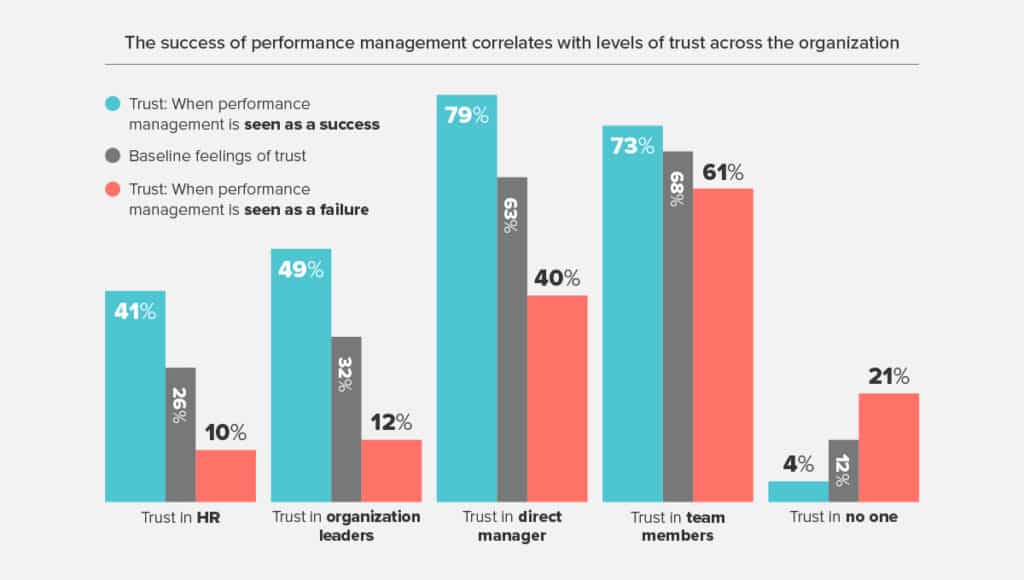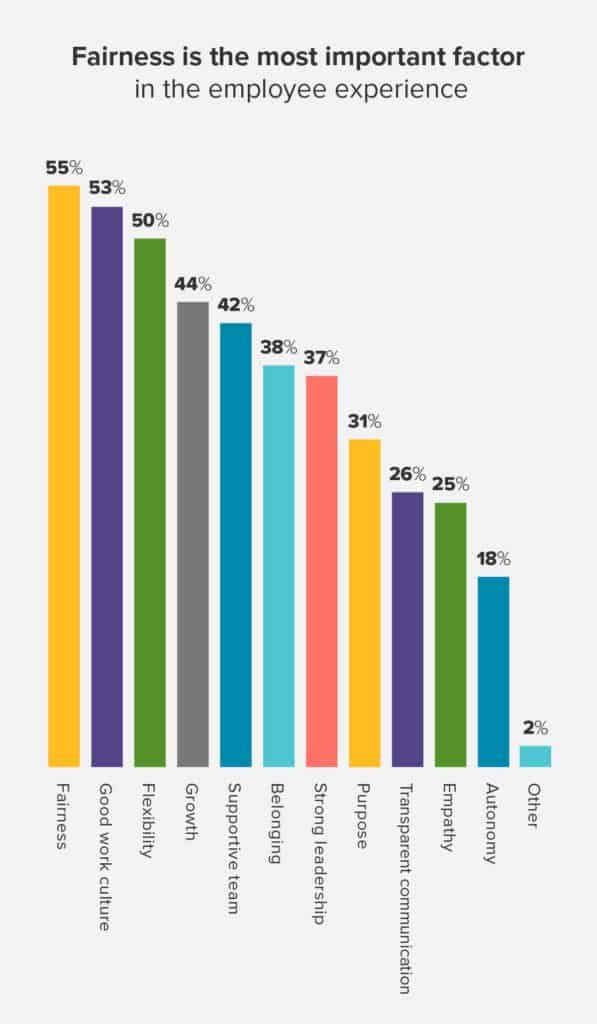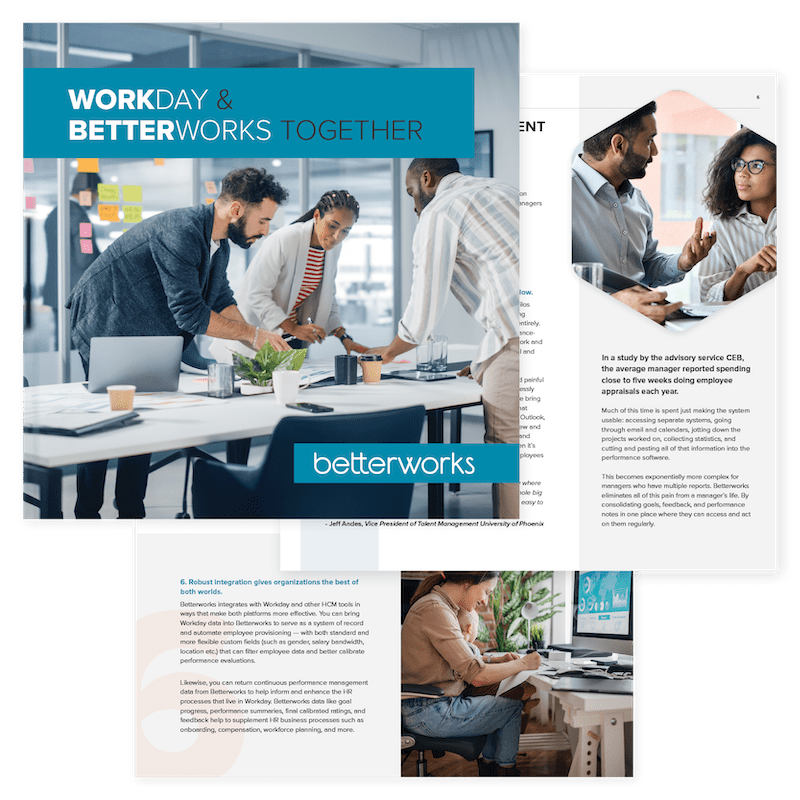Think back to your childhood. Or, if you’re a parent, think back to the last discussion you had with one of your kids about how they’ve been doing at school, the time they spend consuming social media on their phones, their behaviors, or a difficult situation, like bullying or challenges with friends or peers.
When you have had those heart-to-heart discussions, you know that the quality of your relationship greatly impacts their willingness to listen to you, absorb what you say, feel comfort and support, and take action. Certainly, if they don’t trust you much or at all, you’ve got zero influence.
What does this have to do with employees and performance?
All relationships — including those at work — are based on trust. Elevating employee performance starts with trust — with ensuring employees know their organizations have their best interests in mind. As author, speaker, and Cultivayo CEO Jason Lauritsen says, “work is a relationship.” And, the right performance management approach can go a long way toward rebuilding trust in HR and leadership.
Our recently released 2023 State of Performance Enablement report revealed that employee trust in HR is at 26% and at 32% for organization leaders. While these low levels of trust may have roots that go back years, the time to start rebuilding trust is always “now.”

Employee trust affects every aspect of the employer relationship
Employees who trust their HR and organization’s leaders are more likely to feel engaged, committed, and motivated to perform their best work — sharing their ideas, collaborating with colleagues, and taking ownership of their work. When employees feel their leaders and managers genuinely care, are ethical, and value their contributions, it’s no different than the caring relationships we see in families and among friends. As a result, employees are more likely to be productive, innovative, and efficient, which can have a significant impact on the organization’s overall performance.
People spend almost half of their waking hours at work or work-related activities every week. The sheer amount of time, and the value we place on the quality of our time spent and our output (i.e., work) means that work relationships are hugely important and integral to our overall well-being. Dissatisfied or stressed employees don’t bring their best selves to work day after day. They don’t feel cared for, nor do they have high trust in their employers. These are some of the reasons why most HRs updated their scheme of working by getting highly skilled employees with psychology degrees. They are professionals best equipped with the knowledge and skills to help employers in crafting more effective programs for employee engagement. It’s a more effective method of understanding the complexities of employee-employer relations and heightening employee trust in management.
High trust means high-performance
The link between trust and better business outcomes is well-documented: Gallup’s many years of engagement survey data is one example. In 2016, PwC’s Global CEO survey revealed that 55% of CEOs thought a lack of trust threatened growth, according to an HBR article by Paul Zak, founding director of the Center for Neuroeconomics Studies, a professor of economics, psychology, and management at Claremont Graduate University, and the CEO of Immersion Neuroscience. According to Zak’s research, people at high-trust companies report 74% less stress, 106% more energy at work, 50% higher productivity, 13% fewer sick days, 76% more engagement, 29% more satisfaction with their lives, and 40% less burnout than employees of low-trust companies.
Conversely, a lack of trust leads to disengagement, lower productivity and innovation, and increased turnover.
Various studies have found trust impacts an organization’s bottom line: Those with high levels of employee trust outperform the S&P 500 by levels as high as 30% to 50%. According to recent research by IZA World Labor, trust allows businesses to allocate tasks more effectively, which better utilizes employees’ knowledge and skills to improve profitability.
At this point, if you’re thinking, “Tell me something I don’t know,” the question is, ‘How do you fix this?”
The short answer is that fixing a lack of trust and managing trust over time is complex. It’s hard to know where to begin. But, there are actions you can take that will have an outsized impact on your employees.
Pull a big lever: modern performance management
One of the most striking findings about trust levels that came out of the 2023 State of Performance Enablement report was the large delta when employees trusted their performance management processes compared with when they didn’t. Trust in HR and organization leaders quadrupled when employees viewed performance as a success and plummeted when they did not.

The right performance management approach helps you manage trust continuously by positively affecting numerous facets of the employee experience — from fairness (ranked by employees as No. 1 to their work experience) and sense of belonging to good work culture, career growth, and more.

Traditional performance management has 100-year-old roots. Even though it has evolved, it is not well-suited to employee expectations, the realities of modern work, and the speed of change. In fact, it breaks rather than builds trust.
Less than half (46%) of employees see their performance management process as a success, according to our survey. Two-thirds believe performance reviews are a waste of time, including respondents whose companies had made recent changes to performance management.
Just under half said their companies had implemented new processes, technology, or both since 2020. This group was far more likely to have positive sentiments around fairness (lack of bias) in the process, recognition, and the usefulness of performance management to their daily work, so there is much progress. Even so, only 1 in 3 (32%) employees said their performance management process helps them perform better.
Clearly, having the right type of performance management approach matters. It isn’t enough to have new digital processes or systems if managers and employees find they have to expend too much effort but get little usefulness out of their performance tools. Why bother adopting practices and tools that feel overwhelming, time-consuming, and difficult to use, but don’t feel relevant to work, are unmotivating to use, and yield little insight into what matters to the business?
HRIS systems aren’t built for performance management
Often, companies invest substantially in HRIS solutions such as Workday, SAP SuccessFactors, and Oracle, only to find that these systems’ performance management modules aren’t fit for the job. As systems of record, they are engineered for managing recruiting, talent, payroll, and benefits, but they are not designed as systems of engagement.
In fact, Betterworks’ 2022 State of Performance Enablement report found that most employees are dissatisfied with the performance management capabilities embedded in these multifunction platforms. The study found that having software dedicated to goal-setting and feedback correlated with feeling aligned, engaged, and productive — and in every case having the wrong technology tool was worse than having no tools at all.

8 in 10 employees are unhappy with their HRIS system’s performance management. Discover a better way.
Modern performance management is performance enablement
Organizations and employees increasingly realize and expect that performance management must continuously drive engagement to improve organizational performance. With agile and matrixed working models on the rise, enabling discussions of progress against targets needs to be more frequent to help employees stay aligned with their organization’s strategic goals.
Performance enablement moves away from the outdated concepts of hierarchy and control in performance management. Instead, it is based on a framework where employees’ needs are at the center. Simply refocusing on employee needs is an important starting point for building trust with HR and organization leaders.
Performance enablement gives employees the opportunity to create meaningful developmental and performance goals that align with their company’s strategic goals and equips managers to frequently coach and enable employees—rather than dictate and evaluate.
It is the engine that drives engagement, productivity, and greater employee satisfaction. The 2023 research revealed that when employees feel adequately enabled — comprising goal setting and tracking, feedback, and meaningful and ongoing conversations — and have lightweight tools they can access in the flow of work, performance metrics dramatically improve in multiple areas. Employees are:
- 20 percentage points more productive and have far higher levels of engagement
- Twice as likely to say they’re being tasked to work on the right things
- Up to 60 percentage points more likely to say their performance management system helps them perform better at work
- More satisfied with career development check-ins, leading to being up to 7.5X more likely to see a path internally for advancement
- Less than half as likely to be looking to leave their company

How to Build Trust with Employees
Building trust is not an overnight process, but a longer-term effort critical to improving employee performance. In their book, Make Work Better, Betterworks CEO Doug Dennerline and VP of HR Transformation Jamie Aitken state that trust is one of the four key pillars of performance management, along with assurance, teamwork, and shared purpose.
Here are some best practices for building trust with employees:
- Be Transparent: Employees want to know what is happening within the organization and feel like they are part of the decision-making process. Being transparent with your employees about the company’s goals, challenges, and plans can help build trust.
- Listen to Employees: Employees want to feel heard and valued. Encourage employees to share their thoughts and ideas, acknowledge their input, and take action on their feedback.
- Connect: Provide frequent and regular check-ins between managers and employees for coaching, guidance, troubleshooting, and simply building relationships. Enable peer feedback. Employees learn from each other; valuable feedback will strengthen relationships and minimize miscommunication or misunderstanding.
- Provide Opportunities for Growth: Providing opportunities for growth and development can help build trust and engagement with your employees. They need to know their employer is committed to helping them advance — whether to expand skills and responsibilities in a current role or to move into a new position. Building and monitoring career development goals as part of a performance plan is one avenue to bolster this trust.
- Keep Your Promises: When you make promises to your employees, following through to gain credibility and build trust is essential.
- Recognize and Reward Employees: Recognizing and rewarding employees for their contributions shows them you value their efforts.
To learn more about our findings on trust and performance enablement, download your complimentary copy of the 2023 State of Performance Enablement report.
What do employees and managers want?


